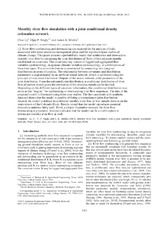| dc.creator | Li, Chao | |
| dc.creator | Singh, Vijay P. | |
| dc.creator | Mishra, Ashok K. | |
| dc.date.accessioned | 2017-09-09T08:16:16Z | |
| dc.date.available | 2017-09-09T08:16:16Z | |
| dc.date.issued | 2013 | |
| dc.identifier.citation | Li, C., V. P. Singh, and A. K. Mishra (2013), Monthly river flow simulation with a joint conditional density estimation network, Water Resour. Res., 49, 3229–3242, doi:10.1002/wrcr.20146. | en |
| dc.identifier.uri | https://hdl.handle.net/1969.1/162120 | |
| dc.description.abstract | River flow synthesizing and downscaling are required for the analysis of risks associated with water resources management plans and for regional impact studies of climate change. This paper presents a probabilistic model that synthesizes and downscales monthly river flow by estimating the joint distribution of flows of two adjacent months conditional on covariates. The covariates may consist of lagged and aggregated flow variables (synthesizing), exogenous climatic variables (downscaling), or combinations of these two types. The joint distribution is constructed by connecting two marginal distributions in terms of copulas. The relationship between covariates and distribution parameters is approximated by an artificial neural network, which is calibrated using the principle of maximum likelihood. Outputs of the neural network yield parameters of the joint distribution. From the estimated joint distribution, a conditional distribution of river flow of current month given the estimation of the previous month can be derived. Depending on the different types of covariate information, this conditional distribution may serve as the ‘‘engine’’ for synthesizing or downscaling river flow sequences. The idea of the proposed model is illustrated using three case studies. The first case deals with synthetic data and shows that the model is capable of fitting a nonstationary joint distribution. Second, the model is utilized to synthesize monthly river flow at four sample stations on the main stream of the Colorado River. Results reveal that the model reproduces essential evaluation statistics fairly well. Third, a simple illustrative example for river flow downscaling is presented. Analysis indicates that the model can be a viable option to downscale monthly river flow as well. | en |
| dc.publisher | American Geophysical Union | |
| dc.subject | Streamflow | en |
| dc.subject | Downscaling (Climatology) | en |
| dc.subject | Distribution (Probability theory) | en |
| dc.subject | Neural networks (Computer science) | en |
| dc.subject | Maximum likelihood statistics | en |
| dc.title | Monthly river flow simulation with a joint conditional density estimation network | en |
| dc.type | Article | en |
| local.department | Biological and Agricultural Engineering (College of
Agriculture and Life Sciences) | en |
| dc.identifier.doi | doi:10.1002/wrcr.20146 | |


